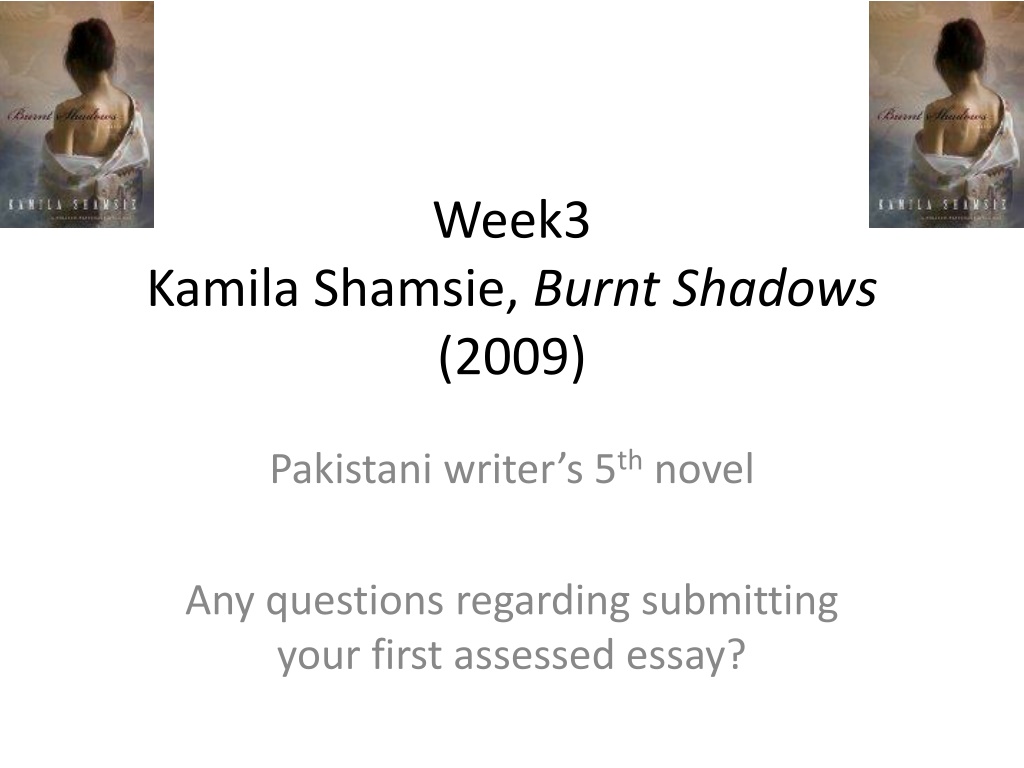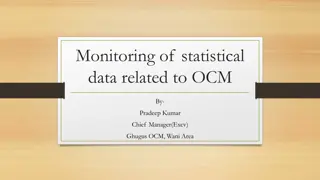Exploring Themes in Kamila Shamsie's Burnt Shadows
Kamila Shamsie's fifth novel, Burnt Shadows, delves into the impact of war on love, loss, and human relationships across decades and continents. Through the stories of two families and the aftermath of the Nagasaki bombing, Shamsie challenges notions of nationhood, human cost of conflicts, and the enduring scars of war, highlighting the need to remember to prevent future devastation.
Download Presentation

Please find below an Image/Link to download the presentation.
The content on the website is provided AS IS for your information and personal use only. It may not be sold, licensed, or shared on other websites without obtaining consent from the author. Download presentation by click this link. If you encounter any issues during the download, it is possible that the publisher has removed the file from their server.
E N D
Presentation Transcript
Week3 Kamila Shamsie, Burnt Shadows (2009) Pakistani writer s 5thnovel Any questions regarding submitting your first assessed essay?
Kamila Shamsie https://www.youtube.com/watch?v=wcK07vO cV7k
Burnt Shadows Kamila Shamsie s fifth novel, Burnt Shadows (2009), is a tale of multiple migrations, and the friendship between two families: the Tanaka- Ashrafs and the Weiss-Burtons, and it takes the reader across six decades from war-torn Nagasaki, to Delhi, Karachi, Afghanistan, the United States, and ultimately, Guantanamo Bay. The novel highlights the horror of war and the nuclear threat and challenges the prejudices and divisive rhetoric of nationhood.
Opening At the start of Shamsie s novel Burnt Shadows, an unidentified man slowly disrobes in a cell, watched by guards who then remove his clothes. When he next dresses, it will be in an orange jumpsuit. There is no need to tell us what this means: the uniform is familiar from a thousand media images. The question hangs there: how did it come to this? Why does Shamsie begin her novel in this way? How does this correlate with the ending of the novel? Does this signal the expendability of non- Americans?
Memory of Nagasaki Burnt Shadows presents itself as about the memory of the bombing of Nagasaki. The novel opens with Konrad Weiss, a German, and Hiroko Tanaka who both live in Nagasaki. Within minutes of becoming engaged, the bomb detonates. Konrad had just begun walking away from Hiroko, towards Urakami Cathedral, which came to be near the epicentre of the nuclear blast; nothing remains of him beyond the shadow, which Hiroko has decided is his, based on it being a longer shadow. Hiroko s back is badly burnt. What is the significance of Konrad and Hiroko s relationship within the novel?
Is this a novel about war? The novel explores he damage it does and about how it becomes possible in the first place. Whilst the novel starts with the bombing of Nagasaki, the novel is more about love and loss as a consequence of war. It also explores how friendship and families are affected in times of conflict, and it asks questions of humanity and how we come to be entangled. Essentially Shamsie establishes the need to showcase the human cost of acts of war is not just called for ethically, but also provides a strong platform for articulating a critique of war. Consequently, it is concluded that the failure to remember the bombing of Nagasaki seems to mean that (nuclear) war remains possible. As shown by Raza s decision to become part of wars, and therefore, she regrets not telling him about her memories. Therefore remembering the scars of war becomes of great significance to the novel.
Four Times, Five Locations Nagasaki 1945 Delihi 1947 Pakistan 1982-3 New York and Afghanistan 2001-2 What is the significance of place within the novel?
The past/the present How did it come to this? : Complex shared histories: against the clash of civilizations thesis (Islam vs West; us/them) Historical correlations between seemingly unconnected places writing against historical exceptionalism (of 9/11; of Partition, etc) Histories of imperialism and neo-imperialism Nations and borders policed through violence and destruction Nations and identities: religious, linguistic States, ideologies, individual fanatics: agents of terror
Hiroko Tanaka Figure of gendered transnationalism--unhomely Young school-teacher turned munitions factory worker; daughter of an artist who is designated as a traitor for speaking out (Hiroko s father is described as an iconoclastic artist who set fire to cherry blossoms commemorating a young boy who died in an act of kamikaze). Translator of languages How can we read Hiroko?
History as loss/Unbelonging Hiroko from Nagasaki Sajjad from Delhi Henry from India Abdullah from Karachi Condition of modernity Displacement Memory and nostalgia
Poetic/Linguistic transnationalism Imagining of different, alternate histories of solidarity and belonging, unmoored from place and identity
Discussion Questions Read through the questions and discuss in pairs and small groups ready to share your ideas with the whole group shortly.























